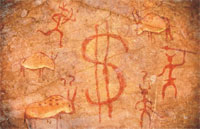
Human beings have always relied on one another to survive. From the dawn of man, we banded together to perpetuate our species, to meet basic needs such as protection, food and childcare, and to derive comfort and pleasure from the company of others.
This primal instinct to think, feel and act based on the broader needs and beliefs of an extended community still lives in us today. We continue to rely on one another both for tangible needs and intangible needs, such as emotional support and love.
We also seek guidance and learn from one another in making decisions large and small — whether it’s choosing a mate, buying a home or finding the best cup of coffee or running shoe. The community-influenced decisions that we make help, in turn, to shape our identities.
By being part of a larger whole, we come to better understand ourselves.
Savvy marketers seek to understand and tap into the primal, tribe instinct. They realize that this instinct is seminal in shaping the identities, emotions and desires of the people with whom they seek to do business and establish long-term relationships. They know that connecting on a tribal, emotional level takes the relationship beyond a transactional, self-serving basis.
In short, they view consumers not just as individuals but as groups of people with things in common: communities or tribes. Looking at brands on the primal level is essential to creating brand communities and evangelists.
How tribes and marketing intersect
Brands can intersect with the primal instinct and tribal communities on different levels.
The most overt, powerful and rare level is when the tribe and the brand are one and the same. Apple — first with its Mac, then with iPod and more recently with iPhone and iPad — has not just created groups of users, but tribes of people for whom the brand is a focal point or platform for sharing common cultures and beliefs.
The second strata of primal-meets-marketing includes brands that truly “get” the common beliefs and culture inherent within the tribes of customers who have embraced them. This list is longer: Patagonia, Jimmy Choo, Nike, Garnet Hill and Aldi Foods are a few examples.
Starbucks, which has traditionally had a place in this sphere, is now striving to reconnect with its tribe with its new campaign, “You & Starbucks. It’s bigger than coffee.”
The most common scenario, however, occurs when a brand approaches the tribe from a relative outsider’s perspective. Here, the tribe is purely defined by the common interests, culture and beliefs of a community — fitness or coffee fanatics, home crafters, home schoolers and so forth. And the brand is seeking only the opportunity or permission to engage with the community in some meaningful way.
Keys to taking your brand primal
So how, exactly, does a brand “go primal”? Here are some key points:
- Recognize and leverage the difference between tribal communities and social networks
Tribal communities are people bound together by a common set of beliefs. They are often connected through physical circumstance — working for the same company or attending group events — or through social networking or other technology.
Further, physical or tech social networks often enable a tribal community to be created or to evolve over time. But the key is to understand that tribal communities and social networks are not one and the same, and that tapping into the tribal community is where the real opportunity lies.
- Start with your brand’s mission and beliefs
Understand and embrace the “why” behind your brand — its purpose for being that goes well beyond the “what” and “how” of what you do.
- Understand the values and beliefs of the tribe with which you wish to connect
It may sound obvious, but this is a lot trickier than you might assume. Research is critical in accurately identifying and defining tribes and their values.
And the research needs to go beyond the shared interests and likes and dislikes. It must reveal how the individuals within a tribe view the world around them and how they define their relationships to that broader world.
- Ask yourself if your brand’s values and beliefs truly align with those of the community or tribe you want to appeal to
If so, you can create a bond that will last a long time; if not, find other tribes whose values mesh with your brand’s.
- Don’t try to force your way in
Listen first, engage later. Brands that earn tribal cred patiently learn about the community and engage carefully, based on what they’ve learned.
Pushiness, overtly promotional messaging or inauthenticity of any kind will be spotted in a millisecond and generate tribal and/or social network backlash. Talking “to” a tribe is seen for what it is: disingenuous and self-serving. Getting invited into the community and facilitating interaction among members is the best course.
- Having a brand “tribal identity” doesn’t lessen or negate the need to strike the right emotional cords
Quite the contrary, in fact — as Starbucks learned the hard way when it offended its tribes by, among other mistakes, cutting back on its comfortable store environments. In truth, making a connection based on genuine personal/brand-consistent beliefs while also tapping a belief of the tribe is the perfect combination.
Establishing and building on primal relationships with your brand’s natural tribes requires unflinching honesty about what your brand stands for, research, patience and long-term commitment. But those that truly grasp and leverage this concept will surely be the ones we’re pointing to as the hot, successful brands over the coming years.
Chad Giddings ([email protected]) is executive vice president, marketing and planning, for J. Schmid & Associates, a catalog consultancy based in Mission, KS.